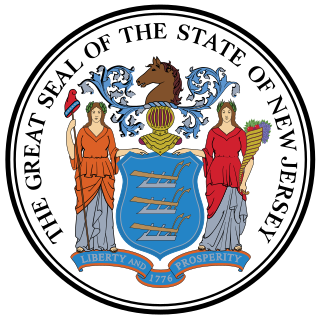Related Research Articles

Electoral systems for the legislatures of the individual Australian states and territories are broadly similar to the electoral system used in federal elections in Australia.

The New Jersey Legislature is the legislative branch of the government of the U.S. state of New Jersey. In its current form, as defined by the New Jersey Constitution of 1947, the Legislature consists of two houses: the General Assembly and the Senate. The Legislature meets in the New Jersey State House, in the state capital of Trenton. Democrats currently hold veto-proof supermajorities in both chambers of the legislature.

The Parliaments of the Australian states and territories are legislative bodies within the federal framework of the Commonwealth of Australia.

The New South Wales Legislative Council, often referred to as the upper house, is one of the two chambers of the parliament of the Australian state of New South Wales. The other is the Legislative Assembly. Both sit at Parliament House in the state capital, Sydney. It is normal for legislation to be first deliberated on and passed by the Legislative Assembly before being considered by the Legislative Council, which acts in the main as a house of review.

The Victorian Legislative Council (VLC) is the upper house of the bicameral Parliament of Victoria, Australia; the lower house being the Legislative Assembly. Both houses sit at Parliament House in Spring Street, Melbourne. The Legislative Council serves as a house of review, in a similar fashion to its federal counterpart, the Australian Senate. Although it is possible for legislation to be first introduced in the Council, most bills receive their first hearing in the Legislative Assembly.

The Legislative Council, or upper house, is one of the two chambers of the Parliament of South Australia. Its central purpose is to act as a house of review for legislation passed through the lower house, the House of Assembly. It sits in Parliament House in the state capital, Adelaide.

The Parliament of New South Wales is a bicameral legislature in the Australian state of New South Wales (NSW), consisting of the New South Wales Legislative Assembly, and the New South Wales Legislative Council. Each house is directly elected by the people of New South Wales at elections held approximately every four years. The Parliament derives its authority from the Queen of Australia, Her Majesty Queen Elizabeth II, represented by the Governor of New South Wales, who chairs the Executive Council of New South Wales. The parliament shares law making powers with the Australian Federal Parliament. The New South Wales Parliament follows the Westminster parliamentary traditions of dress, Green–Red chamber colours and protocol.

The Parliament of South Australia at Parliament House, Adelaide is the bicameral legislature of the Australian state of South Australia. It consists of the 47-seat House of Assembly and the 22-seat Legislative Council. All of the lower house and half of the upper house is filled at each election. It follows a Westminster system of parliamentary government.

The Western Australian Legislative Council is the upper house of the Parliament of Western Australia, a state of Australia. It is regarded as a house of review for legislation passed by the Legislative Assembly, the lower house. The two Houses of Parliament sit in Parliament House in the state capital, Perth.
This is a list of members of the South Australian Legislative Council from 1885 to 1888.
This is a list of members of the South Australian Legislative Council from 1888 to 1891.
This is a list of members of the South Australian Legislative Council from 1891 to 1894.
This is a list of members of the South Australian Legislative Council from 1894 to 1897.
This is a list of members of the South Australian Legislative Council from 1897 to 1900.
This is a list of members of the South Australian Legislative Council from 1902 to 1905.
This is a list of members of the South Australian Legislative Council from 1905 to 1908.
This is a list of members of the South Australian Legislative Council from 1908 to 1910.
This is a list of members of the South Australian Legislative Council from 1910 to 1912
This is a list of members of the South Australian Legislative Council from 1912 to 1915
The Constitution Act Further Amendment Act 1881, No. 236 of 1881, long title "An Act to further amend "The Constitution Act"", was an act of the government of South Australia to amend the Constitution of South Australia. Its purpose was to amend the terms of the Constitution Act 1856 in order to increase the size of the Legislative Council of South Australia from 18 to 24 members, and also to divide the province into four electoral districts each to elect six of the members.
References
- ↑ "The New Constitution Act". The Chronicle . Adelaide: National Library of Australia. 8 March 1902. p. 15. Retrieved 25 October 2014. This article clearly lays out changes brought about by the Act, includes voter statistics and certain criticisms.
